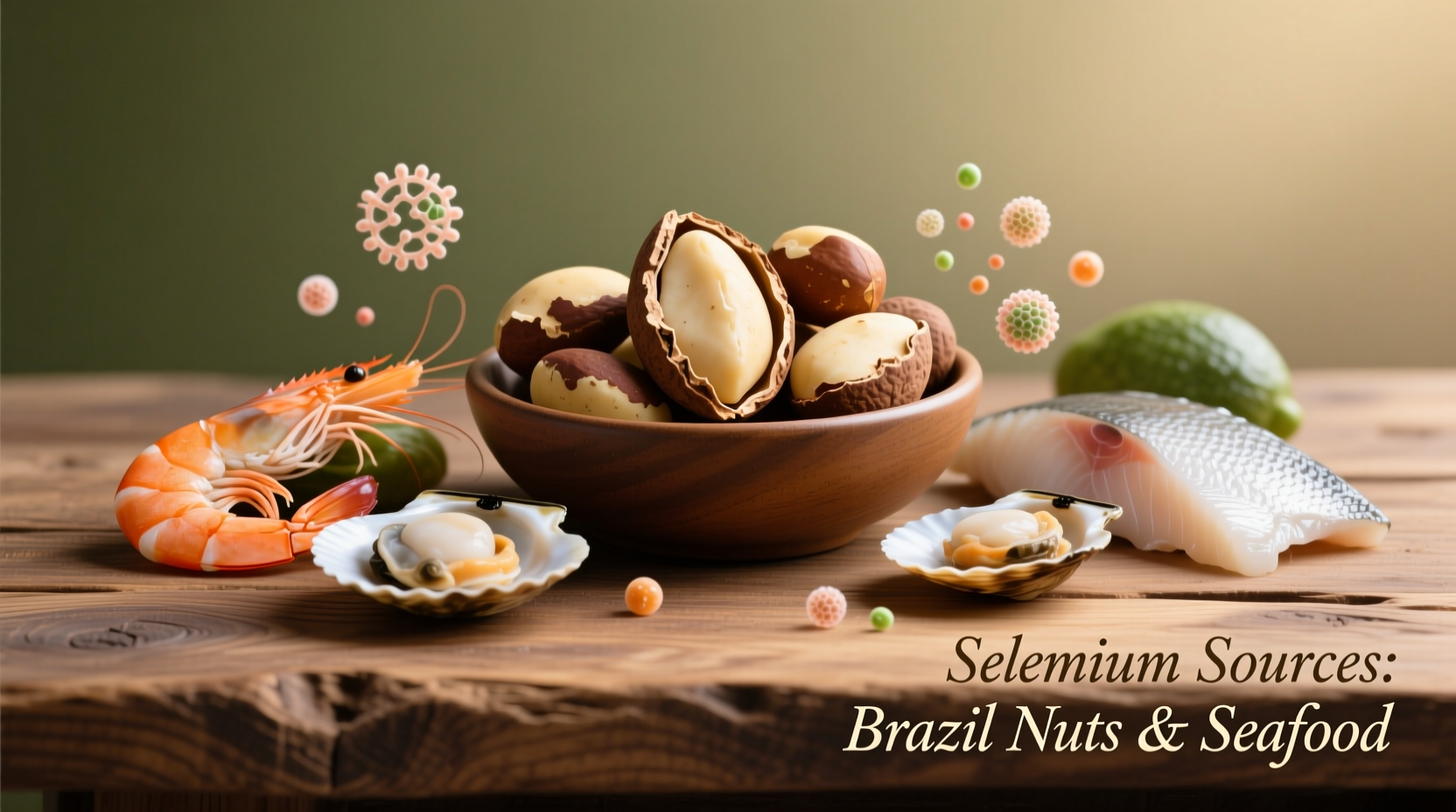Why Selenium Matters for Your Health
Selenium isn't just another mineral—it's a critical component of 25+ selenoproteins that protect your cells from oxidative damage and regulate thyroid hormones. Research from the National Institutes of Health shows adequate selenium intake supports:
- Thyroid hormone metabolism (reducing risk of hypothyroidism)
- Immune cell function (enhancing defense against infections)
- DNA synthesis and repair mechanisms
- Reduced inflammation markers in cardiovascular health
Top 10 Selenium Foods Ranked by Nutritional Value
Based on USDA FoodData Central measurements, these selenium foods deliver the most bioavailable selenium per serving. Note that soil selenium content affects plant-based sources, making animal proteins generally more reliable.
| Food Source | Serving Size | Selenium (mcg) | % Daily Value |
|---|---|---|---|
| Brazil nuts | 1 nut (5g) | 68-91 | 124-165% |
| Yellowfin tuna | 3 oz cooked | 92 | 167% |
| Halibut | 3 oz cooked | 47 | 85% |
| Sardines | 3 oz canned | 45 | 82% |
| Beef organ meats | 3 oz cooked | 33-48 | 60-87% |
| Turkey | 3 oz roasted | 31 | 56% |
| Chicken | 3 oz roasted | 22 | 40% |
| Eggs | 1 large | 15 | 27% |
| Whole wheat bread | 2 slices | 13 | 24% |
| Mushrooms | 1 cup cooked | 11 | 20% |
Source: USDA FoodData Central (2023), values represent average measurements across multiple samples
How Much Selenium Do You Really Need?
The Recommended Dietary Allowance (RDA) varies by life stage according to the National Academy of Medicine:
- Adults (19+ years): 55 mcg daily
- Pregnant women: 60 mcg
- Nursing mothers: 70 mcg
- Children (9-13 years): 40 mcg
Most Americans meet basic requirements through standard diets, but certain populations face higher risks of deficiency:
- People with digestive disorders (Crohn's, ulcerative colitis)
- Those undergoing kidney dialysis
- Individuals living in low-selenium soil regions (parts of Europe, China)
- Vegans in selenium-deficient areas
Timeline of Selenium Research Milestones
Understanding of selenium's importance has evolved significantly over decades:
- 1957: Discovery that selenium prevents liver necrosis in vitamin E-deficient animals
- 1973: Identification of selenium as component of glutathione peroxidase (key antioxidant enzyme)
- 1989: Establishment of first Dietary Reference Intakes by National Academy of Sciences
- 2000s: Research linking selenium status to thyroid autoimmunity and cancer prevention
- 2020: Current understanding of optimal selenium status as a narrow range (neither deficient nor excessive)
Practical Selenium Food Strategies for Daily Nutrition
Instead of obsessing over exact measurements, incorporate these evidence-based approaches:
Smart Pairing Techniques
Combine selenium foods with vitamin C sources to enhance absorption. Try:
- Grilled salmon with lemon-dill sauce
- Turkey stir-fry with bell peppers and broccoli
- Scrambled eggs with tomatoes
Regional Selenium Food Traditions
Cultures worldwide have developed selenium-rich eating patterns:
- Mediterranean: Fish-based diets with regular tuna and sardine consumption
- Scandinavian: High intake of seafood and whole-grain rye bread
- East Asian: Seafood-centered meals with seaweed accompaniments

When Selenium Intake Requires Caution
While deficiency causes problems, excessive selenium creates risks. The NIH identifies these critical boundaries:
- Upper Limit: 400 mcg/day for adults (toxicity risk increases beyond this)
- Brazil Nut Warning: Just 2-3 nuts can exceed daily needs—limit to 1 nut daily
- Supplement Caution: Avoid selenium supplements without medical supervision
- Soil Variation: Plant selenium content varies 100-fold based on growing conditions
Special Considerations for Different Diets
Vegans and vegetarians should note:
- Plant-based selenium absorption is 8-10% lower than animal sources
- Soil selenium content dramatically affects plant foods (Brazil nuts remain reliable)
- Consider getting selenium levels tested if following strict plant-based diets
Your Action Plan for Optimal Selenium Intake
Implement these practical steps today:
- Eat 1 Brazil nut daily (not more) for guaranteed selenium coverage
- Include seafood 2-3 times weekly (3 oz portions)
- Choose pasture-raised eggs over conventional when possible
- Opt for whole grains instead of refined carbohydrates
- Pair selenium foods with vitamin C sources for better absorption
Frequently Asked Questions
What happens if you don't get enough selenium?
Selenium deficiency can cause fatigue, muscle weakness, hair loss, and impaired immune function. Severe deficiency leads to Keshan disease (a type of heart disease) and Kashin-Beck disease (an osteoarthropathy), primarily documented in selenium-deficient regions of China.
Can you get too much selenium from food alone?
Natural food sources rarely cause selenium toxicity. The main risk comes from overconsumption of Brazil nuts (just 4-5 nuts can exceed the upper limit) or inappropriate supplement use. Food-based selenium is generally safe within normal dietary patterns.
Do cooking methods affect selenium content in foods?
Selenium is relatively stable during cooking. Boiling causes minimal loss (5-10%), while roasting and grilling preserve nearly all selenium content. Unlike some vitamins, selenium isn't significantly degraded by heat, making it reliable across various preparation methods.
How quickly does selenium deficiency develop?
Deficiency typically develops over months to years of inadequate intake. Blood selenium levels decline gradually, with noticeable symptoms appearing after 6-12 months of consistently low intake. The body maintains selenium stores in the thyroid and muscles, providing some buffer against short-term dietary gaps.











 浙公网安备
33010002000092号
浙公网安备
33010002000092号 浙B2-20120091-4
浙B2-20120091-4